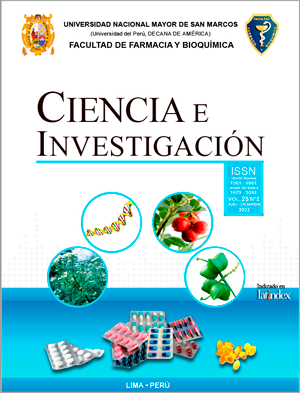Presence of counterfeit miedicines in Peru 2015-2019: socioeconomic and public health consequences
DOI:
https://doi.org/10.15381/ci.v25i2.24858Keywords:
counterfeit drug, gross domestic product, public health spending, out-of-pocket spending, economically active populationAbstract
Objective. To determine the amount of counterfeit drugs admitted to the National Center for Quality Control of the National Institute of Health during the period 2015-2019 and the socioeconomic and public health consequences in our society. Methods. The analysis of the information collected corresponds to counterfeit medicines. This information was processed in a structured spreadsheet with the necessary parameters. Results. Counterfeit medicines in relation to the total medicines analyzed were: 5.7; 7.2; 4.9; 17.0 and 13.3% in 2015, 2016, 2017, 2018 and 2019 respectively. Of 547 counterfeit medicines, according to the ATC Classification, the following therapeutic subgroups stand out: anti-inflammatory and antirheumatic products (22.1%) and antibacterials for systemic use (16.5%). The predominant form of counterfeiting was medicines without an active ingredient (38.6%), followed by those with the correct dose of the active ingredient but from a manufacturer other than the one declared (36.9%). The predominantly counterfeit dosage forms were tablets (69.7%), injectables (8.2%), and capsules (6.8%). 43.7% of counterfeit medicines were of unknown origin. Conclusions. The presence of 8.5% of counterfeit medicines in our country is a problem that not only affects public health, but also causes considerable economic losses, US$177 million per year, and unemployment, 8,791 jobs per year. Metropolitan Lima with 71.7%, continues to be the main focus of the commercialization of counterfeit medicines; whose existence not only occurs in informal markets, but prevails in formal markets. The contribution of this study seeks to be able to develop multisectoral policies that allow stopping the commercialization of these products that represent a scourge in our country.
Downloads
Published
Issue
Section
License
Copyright (c) 2022 Roberto Torres, Fredy Mostacero, Pedro Castillo

This work is licensed under a Creative Commons Attribution 4.0 International License.
LOS AUTORES RETIENEN SUS DERECHOS:
- Los autores retienen sus derechos de marca y patente, y tambien sobre cualquier proceso o procedimiento descrito en el artículo.
- Los autores retienen el derecho de compartir, copiar, distribuir, ejecutar y comunicar públicamente el articulo publicado en la Revista Ciencia e Investigación (por ejemplo, colocarlo en un repositorio institucional o publicarlo en un libro), con un reconocimiento de su publicación inicial en la Revista Ciencia e Investigación.
- Los autores retienen el derecho a hacer una posterior publicación de su trabajo, de utilizar el artículo o cualquier parte de aquel (por ejemplo: una compilación de sus trabajos, notas para conferencias, tesis, o para un libro), siempre que indiquen la fuente de publicación (autores del trabajo, revista, volumen, numero y fecha).






